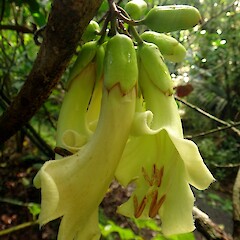Tecomanthe speciosa
Common name
Tecomanthe, akapukaea
Synonyms
None
Family
Bignoniaceae
Flora category
Vascular – Native
Endemic taxon
Yes
Endemic genus
No
Endemic family
No
Structural class
Lianes & Related Trailing Plants - Dicotyledons
Chromosome number
2n = 38
Current conservation status
The conservation status of all known New Zealand vascular plant taxa at the rank of species and below were reassessed in 2017 using the New Zealand Threat Classification System (NZTCS) – more information about this can be found on the NZTCS website. This report includes a statistical summary and brief notes on changes since 2012 and replaces all previous NZTCS lists for vascular plants.
Please note, threat classifications are often suggested by authors when publications fall between NZTCS assessment periods – an interim threat classification status has not been assessed by the NZTCS panel.
- Conservation status of New Zealand indigenous vascular plants, 2017 . 2018. Peter J. de Lange, Jeremy R. Rolfe, John W. Barkla, Shannel P. Courtney, Paul D. Champion, Leon R. Perrie, Sarah M. Beadel, Kerry A. Ford, Ilse Breitwieser, Ines Schönberger, Rowan Hindmarsh-Walls, Peter B. Heenan and Kate Ladley. Department of Conservation. Source: NZTCS and licensed by DOC for reuse under the Creative Commons Attribution 4.0 International licence.
2017 | Threatened – Nationally Critical | Qualifiers: CD, IE, OL
Previous conservation statuses
2012 | Threatened – Nationally Critical | Qualifiers: CD, IE, OL
2009 | Threatened – Nationally Critical | Qualifiers: CD, OL, IE
2004 | Threatened – Nationally Critical
Distribution
Endemic. Three Kings Islands, Great (Manawa Tawhi) Island, Tasman stream. One plant only.
Habitat
Growing up from a stony stream bed within mixed coastal forest dominated by Kanuka (Kunzea triregensis), and pigeonwood (Hedycarya arborea).
Detailed description
Robust leafy vine, producing numerous 4-angled stems 5-20 m long; these initially green to reddish green, maturing pale grey; rooting at nodes. Leaves dark green above, paler beneath, coriaceous, imparipinnate, 3-5-foliolate. Petiole pulvinate up to 60 x 40 mm; petiolules pulvinate 5-10 mm, terminal up to 30 mm. Lamina 50-180 x 30-100 mm, broad-elliptic, broad-obovate, to orbicular, entire, base oblique to cuneate, apex apiculate to retuse. Inflorescences corymbose, 5-50-flowered. Peduncle 20-30 mm, pedicels 10 mm. Calyx 25 x 10 mm, green, tubular, 3-5 lobed. Corolla greenish-white, maturing creamy-white or pale yellow; tube 20-50 x 15-20 mm, cylindric, corolla lobes 5, subacute, recurving with age. Stamens 4, 50-60 mm, fused near tube base. Style 40-60 mm, slender, stigma 2-lobed. Fruits woody, subcylindric capsules 150-200 x 35-40 mm. Seeds 10 x 25 mm, flattened, encircled by a papery, frayed wing.
Similar taxa
None. However, some species of Pandorea, and Jasmine (Jasminium) have a superficial vegetative similarity. The flowers of Pandorea (which is closely related to Tecomanthe) are similar in shape, but are smaller, and usually white, pink or less commonly yellow. Jasmine flowers are very different, being smaller, with longer lobes, white, yellow or pink and strongly scented.
Flowering
Autumn to early winter
Flower colours
Green, White
Fruiting
Year round. Fruit generally mature 3 or so months after flowering but the pods are retained on the vine for up to several years.
Propagation technique
Easily grown from stem cuttings, aerial and ground layering and from seed. Seed must be sown fresh (it will not keep for very long, especially if it has dried out). Place seed on soil surface and water gently. Seed should germinate within 1-2 weeks. Seedlings grow rapidly, and can flower within 2-3 years. Cutting grown plants are more variable with flowering, most nursery stock (which is obtained as cuttings from seedling material) flowers within 2-3 years. However, cuttings raised from the original plant often flower sporadically in the 5 year from cutting,some may never flower at all.
Threats
Only one plant has been found in the wild. This plant was saved from certain extinction by the eradication of feral goats from Great Island (Three Kings) in 1946. Since then the vine has been threatened by the rapid regeneration of the surrounding forest. This has caused shading of the vines habitat such that the plant had suffered serious decline and had not been known to flower since 1946. However following pruning of the canopy and training the vine up cables it has twice shown evidence of light flowering since 1996. However, no seed has yet been set in the wild.
Etymology
speciosa: Handsome
Where To Buy
Common in cultivation and readily available in most garden centres.
Cultural Use/Importance
The cauliflorous, long, tubular, cream flowers are typical of bat pollinated plants. However, bats have never been recorded from the Three Kings Islands (though they may once have been present). Nevertheless, the flowers of cultivated plants are pollinated by a large number of native and exotic birds.
Attribution
Fact Sheet prepared by P.J. de Lange 23 October 2003. Description based on Allan (1961) supplemented with observations obtained from fresh material. This description subsequently published in de Lange et al. (2010)
References and further reading
de Lange, P.J.; Heenan, P.B.; Norton, D.A.; Rolfe, J.R.; Sawyer, J.W.D. 2010: Threatened Plants of New Zealand. Christchurch, Canterbury University Press.
NZPCN Fact Sheet citation
Please cite as: de Lange, P.J. (Year at time of access): Tecomanthe speciosa Fact Sheet (content continuously updated). New Zealand Plant Conservation Network. https://www.nzpcn.org.nz/flora/species/tecomanthe-speciosa/ (Date website was queried)










